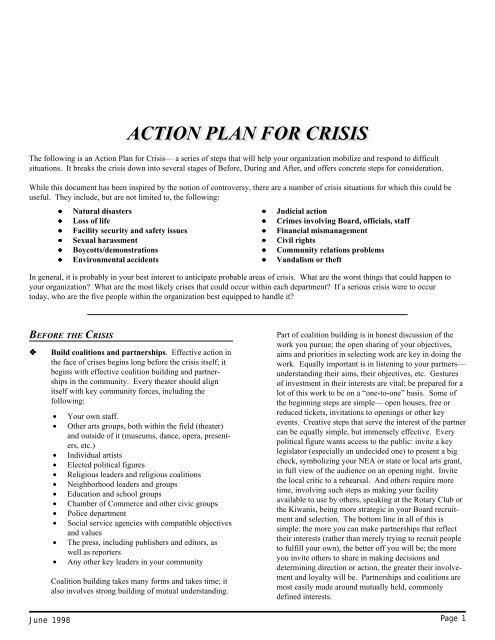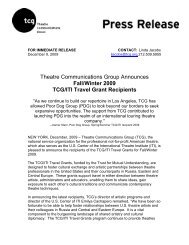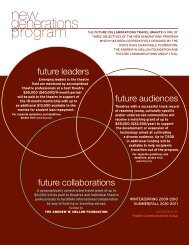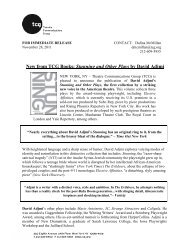Action Plan for Crisis (PDF) - Theatre Communications Group
Action Plan for Crisis (PDF) - Theatre Communications Group
Action Plan for Crisis (PDF) - Theatre Communications Group
- No tags were found...
Create successful ePaper yourself
Turn your PDF publications into a flip-book with our unique Google optimized e-Paper software.
ACTION PLAN FOR CRISISThe following is an <strong>Action</strong> <strong>Plan</strong> <strong>for</strong> <strong>Crisis</strong>— a series of steps that will help your organization mobilize and respond to difficultsituations. It breaks the crisis down into several stages of Be<strong>for</strong>e, During and After, and offers concrete steps <strong>for</strong> consideration.While this document has been inspired by the notion of controversy, there are a number of crisis situations <strong>for</strong> which this could beuseful. They include, but are not limited to, the following:• Natural disasters• Loss of life• Facility security and safety issues• Sexual harassment• Boycotts/demonstrations• Environmental accidents• Judicial action• Crimes involving Board, officials, staff• Financial mismanagement• Civil rights• Community relations problems• Vandalism or theftIn general, it is probably in your best interest to anticipate probable areas of crisis. What are the worst things that could happen toyour organization? What are the most likely crises that could occur within each department? If a serious crisis were to occurtoday, who are the five people within the organization best equipped to handle it?BEFORE THE CRISIS! Build coalitions and partnerships. Effective action inthe face of crises begins long be<strong>for</strong>e the crisis itself; itbegins with effective coalition building and partnershipsin the community. Every theater should alignitself with key community <strong>for</strong>ces, including thefollowing:• Your own staff.• Other arts groups, both within the field (theater)and outside of it (museums, dance, opera, presenters,etc.)• Individual artists• Elected political figures• Religious leaders and religious coalitions• Neighborhood leaders and groups• Education and school groups• Chamber of Commerce and other civic groups• Police department• Social service agencies with compatible objectivesand values• The press, including publishers and editors, aswell as reporters• Any other key leaders in your communityCoalition building takes many <strong>for</strong>ms and takes time; italso involves strong building of mutual understanding.Part of coalition building is in honest discussion of thework you pursue; the open sharing of your objectives,aims and priorities in selecting work are key in doing thework. Equally important is in listening to your partners—understanding their aims, their objectives, etc. Gesturesof investment in their interests are vital; be prepared <strong>for</strong> alot of this work to be on a “one-to-one” basis. Some ofthe beginning steps are simple— open houses, free orreduced tickets, invitations to openings or other keyevents. Creative steps that serve the interest of the partnercan be equally simple, but immensely effective. Everypolitical figure wants access to the public: invite a keylegislator (especially an undecided one) to present a bigcheck, symbolizing your NEA or state or local arts grant,in full view of the audience on an opening night. Invitethe local critic to a rehearsal. And others require moretime, involving such steps as making your facilityavailable to use by others, speaking at the Rotary Club orthe Kiwanis, being more strategic in your Board recruitmentand selection. The bottom line in all of this issimple: the more you can make partnerships that reflecttheir interests (rather than merely trying to recruit peopleto fulfill your own), the better off you will be; the moreyou invite others to share in making decisions anddetermining direction or action, the greater their involvementand loyalty will be. Partnerships and coalitions aremost easily made around mutually held, commonlydefined interests.June 1998 Page 1
! Identify key spokespeople <strong>for</strong> your institution. <strong>Crisis</strong>or not, there should always be a clear sense of who isempowered to speak <strong>for</strong> the organization and in whatsituations. Make sure these people are well trained indealing with media.! Keep your Board fully apprised of the implications ofALL of your work at all times. Again, the time is toolate to open a discussion about challenging work whenthe arts are under attack; your Board must be prepped andready to speak with a unified voice when crisis hits. Andas leaders in their respective communities, they can beour most powerful advocates.! Make sure you have a well developed mission statement.The mission will ultimately be the touchstoneagainst which the crisis and response will be measured. Acrisis is not the time to discover that it is either ill-definedor ill-understood by your organization.WHEN THE CRISIS HAPPENS(AND DON’T THINK IT WON’T)! Don’t panic. Too many groups find themselves introuble simply because they responded too quickly andwithout sufficient thought.! Gather all relevant materials and in<strong>for</strong>mation. Checkgrant files, insurance <strong>for</strong>ms, etc. that you may haveinternally; try to gather any statements, news coverage,etc., that helps you get a clear picture of exactly what thecrisis is. Focus groups can be instrumental in helping youdetermine exactly what the issues are <strong>for</strong> your community.! Convene the key players in your organization andthose affected by the crisis. Board leadership, key staffand individual artists— to come up with a strategy. If atall possible, engage the services of a media-consultinggroup. Some may do it pro bono, others not, but it’samazing what you might find.! Seek legal advice. The one acceptable situation in whichyou can refuse to comment is in the event of litigation.Even here, it is friendlier to say “It is our policy not tocomment on litigation or legal actions” than “Nocomment” (which always sounds like you’re hidingsomething).! Keep your staff and remainder of the Board on top ofevents. Explain what the source of the crisis is and thatyou and key players are devising a strategy. If at allpossible, give a time frame in which the strategy will beannounced. All team members should have the samein<strong>for</strong>mation and be working from the same script as thescenario changes.! Be clear in articulating who will be responsible <strong>for</strong>speaking <strong>for</strong> the organization with the public and insistthat everyone else defer to the spokesperson. Too muchdamage can be done by well-meaning (or not so wellmeaning) insiders, who conjecture or try to explain orgive unauthorized interpretations. Make no exceptions.At the same time, it is naïve to think that others will notbe speaking with friends, spouses/partners, neighbors. Itis essential that they understand the limits of their powerto speak <strong>for</strong> the organization, while at the same timeunderstanding the messages that the organization isputting <strong>for</strong>ward.ASK THE TOUGH QUESTIONS! Were we right? Or were we wrong? Or to what extentwere we right; to which were we wrong? All successfulef<strong>for</strong>ts must be based on an honest, and yet not defensive,assessment of these questions. If you are going to askyour team to defend your actions, you need to be clearabout what you did that was right. If you were right, youshould still ask “What would we have done differently?’’Similarly, you should be prepared to admit that you werewrong if indeed you were. We are all more likely to<strong>for</strong>give someone who says, “You know, we were wrong.We moved too quickly and took a misstep” than someonewho refuses to admit any wrongdoing. Remember Nixon:defensiveness and arrogance can be the biggest enemies.Be prepared <strong>for</strong> this to be painful, but looking within is asimportant as looking outside. Your staff is likely to havestrong feelings. This is the time they can air it; they’ll beasked to walk the party line later.! Know what is essential to be protected. Is it yourreputation? Continued funding? Protection of people’slives? Artistic integrity? Standing in the community?Financial stability? Etc.DEVISING A STRATEGY! Clearly articulate the problem.! Devise two or three key messages. No more. The morekey messages you have, the more diffused the centralmessage to your audiences will be and the more open tomisinterpretation. If we can be of help here at TCG indevising these messages, call us immediately <strong>for</strong> feedbackor ideas. When possible, be specific in your facts butexpansive in your principles; in general, arguing contentof the piece or excellence of the artist, <strong>for</strong> example, is afutile exercise, unlikely to be enough to overcome thecrisis and more likely to mire you in endless fingerpointing. While affirming your dedication to the artist,try to move the conversation to the right of the audienceto decide <strong>for</strong> themselves, the value of having a communitythat encourages diverse expressions, etc.! Measure your key messages against your mission.A reminder of why your organization exists and how theparticular issue fits with your mission (if this is a controversy)is one of your best lines of defense.! Try to anticipate reactions. Ask yourself how peoplewill react, given your approach. How will their reactionsaffect the crisis? How will their reactions affect yourcoalitions and teams?June 1998 Page 2
! Identify your key spokespeople. Keep the circle small;again, the more spokespeople, the greater the confusion islikely to be and the more opportunity <strong>for</strong> misin<strong>for</strong>mation.! Assign specific responsibilities to specific individuals.Don’t inadvertently let the ball get dropped.! Identify specific ways in which your partners andcoalition can help. Petitions? Letters to the editor?Articles in their own publications? A signed roster ofsupporters in your own program? Once you begin toarticulate some helpful ideas, good partners are likely tocome <strong>for</strong>ward with additional ideas of their own.! Decide on a coordinated strategy–a press conference?A series of town meetings? A single interview with asingle paper? A televised interview? Letters? Personalvisits? Telephone calls? Video conference? Advertising?Internal publications/memos? Curtain speeches?(Curtain speeches are a great communication device.You have a captive audience <strong>for</strong> whom you can frame theissue; the absence of an explanation in the midst of acrisis might suggest to your audience that you havesomething to hide.) Faxes? E-mail? Etc.! Whatever your strategy, be ready to handle the media.It’s impossible to predict what they might find a “story.”(A section of General Media Tips appears at the end ofthis plan.)! Determine how success or failure will be measured.How will the team know if the crisis has been handledeffectively?BEFORE YOU RESPOND! Assemble a fact sheet that can be shared with anyoutsider. Come up with a headline that positions you asopen and responsive— “Glad You Asked” or “To Answeryour Concerns” etc. You can present this as a narrative,or as a Q&A <strong>for</strong>mat, addressing anticipated questions.Make the direct answer in the first sentence, with elaboration(if necessary) to follow. Examples: Were peopleinjured in the fire at the theater? Answer: No one wasinjured at the fire. Two people were treated <strong>for</strong> smokeinhalation, etc. Did the NEA fund this project? Answer:There is no public money being used <strong>for</strong> this project. Our1997 grant supported outreach ef<strong>for</strong>ts to elderly citizensand in no way is attached to this ef<strong>for</strong>t, etc. This sheetshould present the facts of the case from your point ofview. Keep the details specific but avoid minutiae; makesure that every fact is in some way linked to one of yourtwo or three key messages; make sure you always tell thetruth.! Assemble your “team” <strong>for</strong> a briefing. Include theremainder of the Board and staff, your key coalitionmembers (always including TCG by now, if notbe<strong>for</strong>e.) Share the results of the thinking so far anddistribute written copies of your fact sheet; identify yourkey messages, the identity of your spokespeople, yoursuggestions <strong>for</strong> their involvement. Literally everyone onyour staff— box office who is likely to come into contactwith the public, actors who are likely to be encountered,etc., needs to be clear on your key messages. Welcometheir ideas— not only <strong>for</strong> their involvement, but <strong>for</strong> yourkey messages as well. Insist on your need to control themessages: you may decide that your originals are the best,but partners can be quite useful in fine tuning or inhelping you prevent being sucker punched in ways youhad not <strong>for</strong>eseen. If at all possible, convene this teamsimultaneously, minimizing leaking rumors. Givenlogistics, it is more probable than many will be notifiedby telephone or in other ways. However you contactthem, make your contacts timely and immediate; coalitionscan be inadvertently disrupted if partners feel theyare being left “in the dark.” Give them a clear timetableof your response.NOW RESPOND! Now and only now are you ready to respond to the greateroutside world and your critics. Follow the strategy youhave devised above.! Distribute your facts sheet or media alert releases.Invite questions to the degree you are com<strong>for</strong>table.! Have a fact checking process. Identify key staff whocan verify facts/allegations from the outside world, aswell as staff who can provide you with concrete facts andfigures you will need to respond.! Have one spokesperson available at all times. Knowspokespeople locations. Make sure all team membershave provided home numbers, weekend numbers, mobilephones/beeper numbers, etc. Make sure the spokespeoplehave these numbers.! Touch base daily to assess the flow of events, the powerof the messages, and future steps you will need to take.! Establish mechanisms to collect in<strong>for</strong>mation fromyour audiences. Devise a way to centrally collect allnews clippings, letters, faxes, e-mails, etc. If appropriate,survey your audiences.! Be patient. These things take time and energy.! Take time to thank your partners with a quick phonecall or a note. All of your partners deserve a note ofthanks, even if ultimately they are unable to join youref<strong>for</strong>ts— at least thank them <strong>for</strong> their time in joining youto discuss the issues and hear you out. You might needthem in another context that they are more com<strong>for</strong>tablewith in the future!! Additional thanks are due when their ef<strong>for</strong>ts are visible,e.g. a quotation in the press, an interview, etc. Everyonelikes to know his or her ef<strong>for</strong>ts are making a difference.! Don’t be afraid to ask <strong>for</strong> help or articulate your ownneeds. Take a day off if you need to; better to be reenergizedand ready than overextended and burned out. Theoffhand remark born of fatigue can do far more damagethan you can imagine. Simply be clear in appointing thechain of responsibility in your absence.June 1998 Page 3
AFTER IT’S OVER! Look backwards and assess your actions. What didyou learn? What did you do well? What could you havedone better? Invite your team to share in this “postmortem.” Survey the media to determine with journalistsand editors how well in<strong>for</strong>med they felt. Sound outexternal publics as well. Record your thoughts <strong>for</strong> yourown files; what may appear to be the resolution of a crisismay merely be the end of the first stage. And share yourthoughts with us so that we can share your perceptionswith the field.! Analyze how the crisis has affected the bottom line.! Devise a second strategy response <strong>for</strong> the same issue.Many controversies have flared again after the organizationsbelieved that the crisis had passed, and this “secondround” is often even more devastating. Try to articulatethe issues that may not have been entirely laid to rest, orthose that somehow never came up at all; devise answers<strong>for</strong> each.! Thank your team yet again. A victory party at anylevel—even simply a bag of chips and some sodas—willgo a long way to making your gratitude seem more thanlip service.! Go back to “BEFORE THE CRISIS” and startbuilding new coalitions and teams: are there any that hadopposed you that you might now stand to convert? Andnow embrace the fact that, as a member of a coalition,you need to be among the first to rally to their defense.A FINAL WORD ABOUTDEALING WITH THE MEDIA! Remember a key rule in dealing with the press: THEREIS NO SUCH THING AS “OFF THE RECORD.” Ifyou’re not willing to say it on the record, don’t say it atall.! Eliminate the phrase, “No comment” from yourvocabulary. It gives the impression that you’re coveringup. Staff can say, “I don’t really have the authority toaddress that; you’ll need to speak to Mr. X or Ms. Y” istruthful and more helpful; “I cannot talk about that at thistime but I will get you the in<strong>for</strong>mation as soon as I can”or “We consider that private in<strong>for</strong>mation” (if they ask, <strong>for</strong>example, what you are paying to key personnel) are allmore helpful and open responses.! Do not answer questions that do not pertain to yoursituation.! Never repeat a negative or an accusation back to areporter.! Speak in short, direct sentences. Like it or not, we livein the era of the sound-bite. Speak carefully; the 30second sound-bite is the general rule. Make sure thatevery 30 second unit is something you would want to seeor hear through the media.! Do not debate your issue in the media. Make your case;don’t get drawn into debate,! Stay calm. Never get emotional with the press.! Never lie. Ever, ever, ever. You may always respond “Ido not know” or “I cannot say.”! Never speculate. Reporters love to get you to answerquestions about hypothetical situations. Don’t fall intothe trap.! Control on-camera interviews by specifying locale. Aquiet place “away from the action” will convey a greatersense of calm and control.! Set time limits <strong>for</strong> interviews and stick to them.Specified time limits <strong>for</strong>ce the reporter to focus on themost pressing issues and minimize the chances that yourkey messages will get lost in a shuffle.! Finally, correct inaccuracies. Demand retractions/clarifications/apologies where there has been wrongfulmisrepresentation. Be prepared to go above the reporter’shead if necessary, but take this step only if the reporterhas the in<strong>for</strong>mation wrong and is not prepared to correctit. Remember, keeping the reporter’s good will is key toone of the coalitions you want in your community.. . .AND ONE MORE FINAL, FINAL NOTEWe view this document as a work in progress. With everycrisis, we are likely to learn more. Please communicate withus about the usefulness of this plan— were there unnecessarysteps? Did we leave things out? How could we have beenmore helpful? We will be happy to distribute new documentsas we continue to refine and use this plan.June 1998 Page 4










